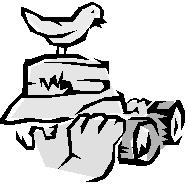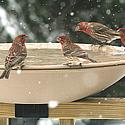Blog - General
Daves Bird Chatter November 2014

This is a wonderful time of year to get outdoors before more frigid weather arrives. Take a field guide and a pair of binoculars and enjoy the birds you see. Watch for hawks sitting along the roadway. Its great fun just to keep track of the number of birds you can observe. Just a short drive or walk down a trail will produce an amazing number of bird species during the fall bird migration.
The ducks and geese are really getting restless this month, and soon they will be heading toward their winter territories in the Southern States. Some will remain if they locate open water. Salt Creek, Haines Branch, Oak Creek and Little Salt Creek in Lancaster County remain open in places during the winter due to the high salinity of the water. Several small tributaries into Salt Creek remain open as well passing through the salt marshes. These saline waters only occur on the west side of Salt Creek. On the east side plenty of fresh water streams flow into Salt Creek. These riparian areas harbor an abundance of birds as well. Steven’s Creek, Antelope Creek, Dead Man’s Run, and Beale’s Slough. Several of these creeks have trails that run adjacent to them or cross them several times. The Salt Creek watershed lakes also support many birds until the water freezes over for the winter.
Seasonal changes usher many birds into and through Nebraska. With 450 bird species on Nebraska’s bird checklist it makes the state one of the best birding regions on the North American Continent. Each season brings a new variety of birds including vagrants and rare species.
We have received numerous reports of Red-breasted Nuthatches, Pine Siskin, Goldfinch, Junco’s and native sparrows showing up in backyards at the bird feeders, alongside our common resident birds. With the recent arctic fronts pushing south out of Canada it will drive many more northern birds into our area where they will spend the winter. Red Polls, Evening Grosbeaks, Crossbills, and Purple Finch may appear in your yard at any time. No one knows what bird may drop by their backyard. It could be a Snow Bunting or a Brown Creeper so be observant.
It seems as though it is the casual bird feeder who notices an unusual bird that appears in their yard. The main thing is if you do see a bird show up that is not one of the common birds that visit your bird feeders, try to identify it. If you can’t, contact the Wild Bird Habitat Store or someone who can help. Most of the really rare birds are found in this manner.
Keep the water in the bird bath open and fresh. Remember birds have numerous food sources staked out during the winter as to not rely on any one food stock. But water can be a resource which is difficult to locate outdoors in freezing temperatures. If you do not have water available for birds in the winter, maybe this would be a good year to add it to your bird feeding program.
If you use a heater in your bird bath during the winter now is the time to clean it up and make certain it is in working order. Do the freezer test . Place your heater in the freezer for twenty minutes. This will activate the thermostat. Remove it from the freezer and plug it in. It should begin to warm up. Bird bath de-icers either work or not, there is no “kinda works”. If they only warm up slightly then they may need scale and other deposits cleaned off. This can be accomplished by mixing vinegar with water then soaking the de-icer and scrubbing with a stiff brush to remove deposits.
. Place your heater in the freezer for twenty minutes. This will activate the thermostat. Remove it from the freezer and plug it in. It should begin to warm up. Bird bath de-icers either work or not, there is no “kinda works”. If they only warm up slightly then they may need scale and other deposits cleaned off. This can be accomplished by mixing vinegar with water then soaking the de-icer and scrubbing with a stiff brush to remove deposits.
Although many people reported a lack of birds over the past few weeks, they are now beginning to return to the feeders, and many more will join them. In September an abundance of natural foods become available and the birds will take advantage of those foods knowing it won’t last. Although they have been busy staking out numerous natural food plots for winter, they know where the bird feeders are and will use them as a supplemental food source. This is why we recommend keeping your feeders filled during this slow period. As northern birds return for the winter, and the temperatures continue to slide toward zero, I guarantee the activity at the bird feeders will return.
Will we have snow before Wild Bird Habitat’s December newsletter is on the shelf? Hard to say, but winter is fast approaching. Keep the suet out as it provides a good source of protein and fat for woodpeckers and nuthatches. More Carolina Wrens are reported every year opting to spend the winter in more northern states as previous years. They will occasionally call during the winter when most birds are silent. This bird has the typical turned up tail as do all wrens. Along with the distinctive tail, look for the white eyebrow which makes identification fairly easy. They too find the suet feeder and shelled peanuts an attractive source of high energy protein during the cold winter months.
Keep the feeders filled. Maybe add a new style of bird feeder this year to attract a larger variety of birds. Keep the binoculars handy and a good field guide close by. If you want to move your bird feeders so they are more visible from inside the house, now is a good time to do it. If you need any hardware, Wild Bird Habitat has a variety of hooks, poles, and hangers and plenty of good information on installation. We hope everyone has an exciting experience during the fall bird migration.
